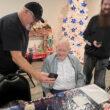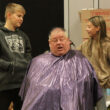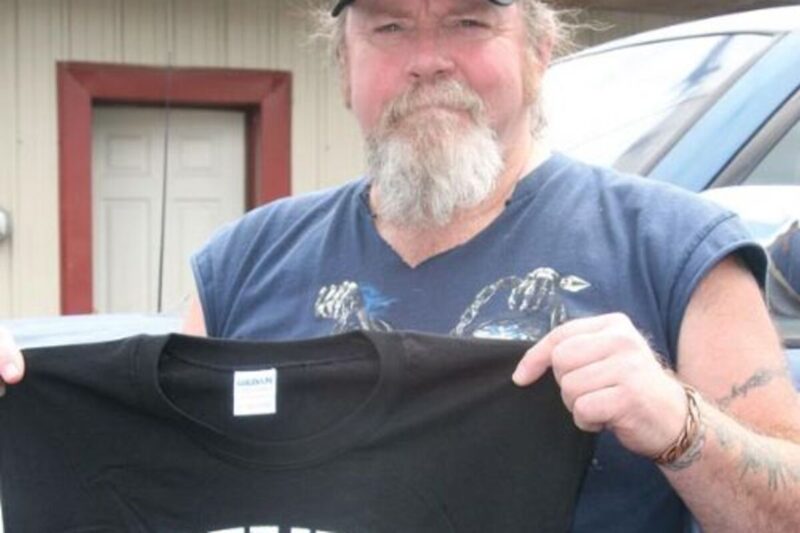Sean C. Morgan
After a little more than a year and a half, Vietnam veteran Mike Stone has printed some 1,600 T-shirts with a design that honors those who have served in the military, giving away 800 of them to veterans of Iraq and Afghanistan.
He is nearly out of the shirts and is thinking that he will retire the shirt, which he designed to honor the late Sam Huxford, a veteran of Afghanistan and stepson. Huxford died in a car crash earlier this year while coping with post-traumatic stress disorder.
“The market’s gotten saturated,” Stone said. With Huxford’s passing on April 14, “I’ve kind of lost heart in printing more of them. I kind of feel like retiring the shirt because of Sam. I wanted to honor him.”
The design features a skull representing the horror of war and horrible evils the soldiers are going through. The red points in its eye sockets are the shapes of Afghanistan and Iraq. Below the skull are the outlines of a gunner on a Humvee on one side and on the other, a soldier in the desert with a Chinook helicopter in the background. The word “Vets” is stenciled across the top. At the bottom is written, “All gave some. Some gave all.”
Stone has sold the shirts for $20 each to help pay for printing them. For each one purchased locally, he gave one to a soldier serving in Iraq or Afghanistan. He had likened the shirts to a “hug from home because it wraps around you.”
Stone, who is a tattoo artist at Body Mine Tattoo, 1228 Main St., said last week that he doesn’t have an exact count of how many shirts he has left. He has mostly small and medium shirts left with some large and extra large.
“I carry them with me, usually,” Stone said. “If we run into a soldier with his uniform on, we’ll ask him what size you are.”
Stone clears up the confusion quickly by giving the soldier a shirt.
The response from the soldiers has been incredible, he said. He has heard back from soldiers who have received the shirts. Some wear them immediately, while others won’t wear them until they return home. Other people ask them where they got the T-shirts.
When National Guard members from the Lebanon and Sweet Home areas returned from Iraq, Stone provided shirts to them.
“That was like Christmas to us to let those guys know how much we appreciate them,” Stone said.
Stone said he also gave a T-shirt to one of the members of the Easy Company portrayed in HBO’s “Band of Brothers,” an 11-hour World War II miniseries based on a book written by historian and biographer Stephen E. Ambrose. The story follows the Easy Company of the Second Battalion, 506th Parachute Infantry Regiment assigned to the 101st Airborne Division of the U.S. Army from training and Normandy, Operation Market Garden and the Battle of Bastogne to Hitler’s Eagle’s Nest.
Stone gave the shirt to Technical Sergeant Donald G. Malarkey, who lives in Salem.
The amazing thing about it is not only being able to give the T-shirt to a veteran but the response, Stone said.
Stone said he made the shirt for his stepson.
“We looked in each other’s eyes,” Stone said. “You don’t have to say anything. You just know. You can see that sorrow and sadness in the back of the eyes. I saw the same in Sam.”
Helping returning veterans deal with that pain was a large part of Stone’s motivation. It was a way to reach out to the soldiers and to honor and respect them as veterans.
Stone related the story of a friend, a Vietnam veteran from Salem.
“He said when he got home, ‘I couldn’t take it,’ exactly like Sam,” Stone said. “He said, ‘I had to get out of there. It was just too much.’”
The veteran went up into the hills around Grants Pass, Stone said. He set up caches of ammunition and stayed in the hills for a few years. He would periodically resupply, returning to populated areas and stealing what he needed.
He had been living in the hills for so long that he was surprised when he heard a voice. The voice belonged to another man planning to burglarize a house for money. They struck up a deal to burglarize it together, and they got caught.
“He went to prison, and in prison is where he started getting help with post-traumatic stress disorder,” Stone said. The story shows how troubled vets can be with PTSD, and it happens in every war, including to himself, he said.
“I did not know what was wrong with me,” Stone said. He had served two tours in Vietnam as a cook. During his first tour, he worked for a security-intelligence unit. During his second tour, he worked in an artillery unit in the field and in the thick of the action.
He served with his brother. They returned from the war in the middle of the night, avoiding the protestors who would spit on them, but contributing even further to the PTSD they would face.
He and his brother lost a year drinking and traveling, Stone said, but when his wife became pregnant, he decided to get a job and try to make a normal life.
His wife would go off on an affair periodically, while he would disappear into his art studio for hours.
“We didn’t know how to communicate in those days,” Stone said. Drugs, meth, finally brought him to his knees. Three years after getting clean, he still had problems. That was about 1988.
“I said, ‘Look, I quit drugs. I ought to be fine,’” Stone said. “(But) I had an anger problem. That’s when I went into the Vet’s Center.
At the Vet’s Center in Salem, he learned that he might have PTSD, Stone said. After that, it took two years before he felt he could trust someone enough to tell his story.
With PTSD, anywhere a veteran feels helpless triggers that reaction, Stone said. Even at a check stand, a door opening behind a veteran, anything outside the veteran’s control, it can just start. Even knowing what’s coming with a fireworks display, the sounds of explosions can still make Stone jump.
The cold response, forcing him to return to the states in the middle of the night, contributed to the PTSD too, Stone said.
“If you’re a soldier, you’re going to go through PTSD,” Stone said. It’s universal. He recalled hearing about it from a Russian soldier, who was a guest speaker for a veterans group, telling his story from the Soviet Union’s invasion of Afghanistan in the 1980s.
“You remember the fear, to where your heart is beating in your throat,” Stone said, recalling battle, the smell of blood, burning hair, the dust rising when a rocket hits and more. “It’s so fearsome and the adrenaline is so thick in your body and your veins. You can’t imagine coming out this until your heart is about to explode.”
Stone’s T-shirts are meant to help the next generation of veterans, but they help him too, he said. They serve as a form of therapy for him too.
He is designing new shirts for all veterans, Stone said. “As far as the design for Sam, I think I ought to let that rest.”





